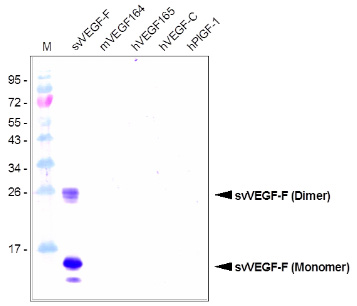VEGF-F / svVEGF Rabbit Polyclonal Antibody
Specifications
| Product Data | |
| Applications | WB |
| Recommended Dilution | Western blot: 2-5 μg/ml. |
| Reactivities | Snake |
| Host | Rabbit |
| Isotype | IgG |
| Clonality | Polyclonal |
| Immunogen | Highly pure (>95%) recombinant snake venom VEGF-F (Gly24-Val146) derived from E. coli |
| Specificity | This antibody detects VEGF-F. |
| Formulation | PBS, pH 7.2 State: Purified State: Lyophilized Ig fraction |
| Reconstitution Method | Centrifuge vial prior to opening. Reconstitute in sterile water to a concentration of 0.1-1.0 mg/ml. |
| Purification | Protein-A purified |
| Conjugation | Unconjugated |
| Storage | The lyophilized antibody is stable at room temperature for up to 1 month. Following reconstitution antibody can be stored at 2-8 °C for up to two weeks or (in aliquots) at -20 °C for longer. Avoid repeated freezing and thawing. |
| Stability | Shelf life: one year from despatch. |
| Database Link | |
| Background | Vascular endothelial growth factor (VEGF-A) and its family proteins are crucial regulators of blood vessel formation and vascular permeability. Snake venom has recently been shown to be an exogenous source of unique VEGF (known as VEGF-F), and now, two types of VEGF-F with distinct biochemical properties have been reported. VEGF-Fs (venom type VEGFs) are highly variable in structure and function among species, in contrast to endogenous tissue-type VEGFs (VEGF-As) of snakes. Although the structures of tissue-type VEGFs are highly conserved among venomous snake species and even among all vertebrates, including humans, those of venom-type VEGFs are extensively variegated, especially in the regions around receptor-binding loops and C-terminal putative coreceptor-binding regions, indicating that highly frequent variations are located around functionally key regions of the proteins. Genetic analyses suggest that venom-type VEGF gene may have developed from a tissue-type gene and that the unique sequence of its C-terminal region was generated by an alteration in the translation frame in the corresponding exons. The svVEGF-F was identified during the generation of abundant expressed sequence tags from the Viperidae snake Bothrops insularis venom glands. The deduced primary sequence, after complete sequencing of the longest snake venom VEGF (svVEGF) cDNA, displayed similarity with vertebrate VEGFs and with the hypotensive factor from Vipera aspis venom. The mature svVEGF appears to be ubiquitously distributed throughout snake venoms and was also confirmed by Northern blot studies of other related Viperidae species and by cDNA cloning of svVEGF from Bothrops jararaca pit viper. The produced recombinant protein dimerizes after refolding processes and was biologically characterized, showing ability to increase vascular permeability. These results established that svVEGF is a novel and important active toxin during the early stages of bothropic snake bite envenoming and represents a new member of the VEGF family of proteins. |
| Synonyms | Snake venom vascular endothelial growth factor toxin |
| Note | Endotoxin level: < 0.1 EU/1µg of the antibody (LAL) |
| Reference Data | |
Documents
| Product Manuals |
| FAQs |
| SDS |
{0} Product Review(s)
0 Product Review(s)
Submit review
Be the first one to submit a review
Product Citations
*Delivery time may vary from web posted schedule. Occasional delays may occur due to unforeseen
complexities in the preparation of your product. International customers may expect an additional 1-2 weeks
in shipping.






























































































































































































































































 Germany
Germany
 Japan
Japan
 United Kingdom
United Kingdom
 China
China



